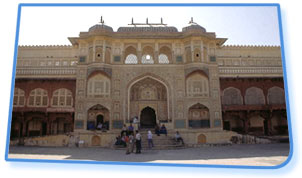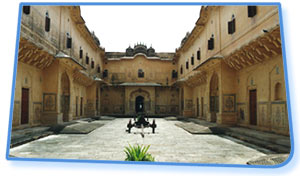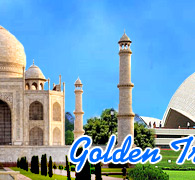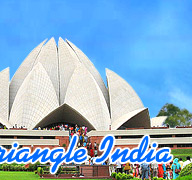 Raja
Man Singh erected Amer Palace in 16th century. It is a mesmerizing
amalgamation of Hindu and Mughal architecture. Rajputs made use of this
Amber Fort from the 16th century up to the foundation of Jaipur in 1727
both for defense reasons as well as the residential reasons. Thus within
its powerful walls, one finds charismatic gardens and magnificent
palaces made from marble and precious stones, richly festooned with
intricate stonemason works and paintings, which corresponded to royal
splendor and luxury.
Raja
Man Singh erected Amer Palace in 16th century. It is a mesmerizing
amalgamation of Hindu and Mughal architecture. Rajputs made use of this
Amber Fort from the 16th century up to the foundation of Jaipur in 1727
both for defense reasons as well as the residential reasons. Thus within
its powerful walls, one finds charismatic gardens and magnificent
palaces made from marble and precious stones, richly festooned with
intricate stonemason works and paintings, which corresponded to royal
splendor and luxury.Situated at Jaipur, the mirror image of Amber Fort in the lake below looks almost divine. It is not at all surprising to know that this grandiose and stately fort was once the Capital of Minas. Amer Fort accommodates Jai Mandir, a famous temple which has Sheesh Mahal, a delightful hall of mirrors that are so artistically set that even a tiny ray of light gets replicated in the mirrors and illumines the hall flamboyantly. Sheesh Mahal is famed all over the world as one of the most sought-after tourist attraction. Other places of interest in this fort are Sukh Niwas and Ganesh Pole.
City Palace
A combination of conventional Rajasthani and Mughal architecture, City Palace complex has more than a few palatial structures. Maharaja Jai Singh built the external wall but there have been many additions since then. It stretches across one-seventh of the area of the walled city and is in part of the palace still serves as imperial residence. The tourist attractions of the palace are Chandra Mahal, Badal Mahal, Shri Govind Dev Temple and the City Palace Museum.
The first courtyard of the palace accomodates the 'Mubarak Mahal' or the Fortunate Palace, built by Maharaja Madho Singh II contains the textile section of the Maharaja Sawai Man Singh II Museum. 'Chandra Mahal', or the Moon Palace, is a gigantic seven storeyed structure. It is also the present-day residence of the Maharaja of Jaipur and providing awe-inspiring views of both the gardens and the city. It is ornamented in a traditional style by floral decorations, paintings, mirror walls and ceilings.
Nahargarh Fort
 Embraced
in the Nahargarh Hills, the Nahargarh Fort of Jaipur was erected by
Sawai Raja Jai Singh in 1734. Jaipur was the capital of Raja Jai Singh
II and Nahargarh was an appropriate stand guard, rightly called the
Tiger Fort. It was the first of the three forts built by the rulers of
Jaipur. Though in ruins, there are pretty buildings that the fort holds,
added by Sawai Ram Singh II and Sawai Madho Singh II in the 19th
century, which have been well preserved. It offers some
out-of-this-world views of the Man Sagar Lake and the city below.
Attention-grabbing folklores ring in every nook and corner of the fort.
A palatial duck blind stands with poise in the midst of the lake, which
once allured the shooting parties of the regal family. It has also
served as a private treasury for years and an imperial retreat for the
queens.
Embraced
in the Nahargarh Hills, the Nahargarh Fort of Jaipur was erected by
Sawai Raja Jai Singh in 1734. Jaipur was the capital of Raja Jai Singh
II and Nahargarh was an appropriate stand guard, rightly called the
Tiger Fort. It was the first of the three forts built by the rulers of
Jaipur. Though in ruins, there are pretty buildings that the fort holds,
added by Sawai Ram Singh II and Sawai Madho Singh II in the 19th
century, which have been well preserved. It offers some
out-of-this-world views of the Man Sagar Lake and the city below.
Attention-grabbing folklores ring in every nook and corner of the fort.
A palatial duck blind stands with poise in the midst of the lake, which
once allured the shooting parties of the regal family. It has also
served as a private treasury for years and an imperial retreat for the
queens.Jai Garh Fort
Not very far from the Amber Fort, Raja Sawai Jai Singh erected the Jaigarh Fort (translated as fort of conquest) in 1726. This earlier royal treasury in Jaipur is extraordinarily well preserved for the military structures of that period and is regarded as one of the three strongest forts of India. The fort perches on a cliff and is surrounded by mammoth fortification walls, which have inside pathways that offer astonishing views on all sides. It houses the World's largest cannon on wheel, Jaivan. Its ingenious planning is quite evident in its complicated water supply and storage system. Similar to Amber Fort in structure, Jaigarh Fort provides some extravagant views of Jaipur and Amber Fort from the Diwa Burj watchtower. There was tittle-tattle that there was a large treasure of gold obscured in the premises of the fort. Thus, it had to be preserved from the public for seven long years. Now, it has been opened to the public to put on show its several striking palaces, gardens, its granary, an armory that has a dazzling collection of arms and weapons and its temples.
Jal Mahal
Erected to be a pleasure palace for the imperial family in 1799, Jal Mahal Palace (translated as Water Palace) of Jaipur is an exceptionally romantic place with its red sandstone elaborate architecture casting beautiful reflections in the unruffled waters of the Man Sagar Lake, which is full of hyacinths. Enveloped by Nahargarh Hills, Jal Mahal is known for its superb architecture and erudite design. It was once used for the regal duck shooting parties. It has also been abode to one of the prime ministers of Jaipur estate. Though forsaken, it is very well preserved and provides a quaint view from Nahargarh Fort. Set contrary to the cenotaphs of the royal family, the first four floors of Jal Mahal is under water and only the top floor is higher than the water level. The lake environment is a preferred home of a number of migratory and resident birds. The Mansagar Dam is to be found on the eastern side of the lake and provides a good vantage point for screening the lake and the valley.
Jaipur Hotels : Samode Palace - Jai Mahal Palace - Rajputana Palace Sheraton - Rambagh Palace - Trident Hilton












